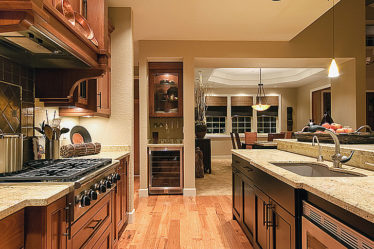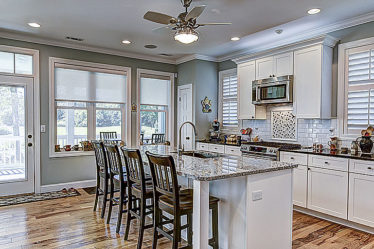
When envisioning significant transformations, the mind often gravitates toward commercial remodeling. However, a complete home renovation carries equal weight, necessitating thorough planning and execution. The objective is to translate conceptual visions into tangible living environments while meticulously attending to every detail.
Grasping the Essence of Home Renovation
A complete home renovation entails a comprehensive overhaul of nearly every aspect, both interior and exterior. It encompasses substantial changes, such as reimagining spatial configurations by eliminating barriers or introducing innovative elements. This sets it apart from limited home updates, which focus on specific areas or rooms.
Essential Terminology in Home Renovations
- Estimates: Initial calculations that approximate project costs, factoring in elements such as scope of work, materials, and labor. It’s important to note that estimates serve as preliminary figures and may fluctuate as the project progresses. Employing construction estimating tools can prove advantageous in this regard.
- Proposals: Structured documents presenting detailed project specifications to homeowners, providing clarity and insight into the proposed undertaking. Modern construction proposal tools seamlessly bridge the gap between estimates and formal proposals.
- Invoices: Comprehensive records documenting expenses associated with completed tasks, issued periodically for homeowner review and payment processing.
- Budgets: Financial frameworks comparing projected costs against actual expenditures to ensure projects remain within predetermined financial boundaries. Contemporary construction budget tools offer real-time updates, fostering transparency throughout the project lifecycle.
- General Contractors: Companies entrusted by homeowners to oversee and manage construction tasks, responsible for ensuring timely and budget-compliant project completion.
- Subcontractors: Skilled professionals enlisted by general contractors to perform specialized tasks, such as plumbing or electrical work, under their supervision.
- Project Plan: Comprehensive documentation outlining project objectives, scope of work, timeline, and budgetary considerations. Both homeowners and contractors rely on this roadmap for guidance and reference throughout the project lifecycle.
- Project Materials: Tangible resources, including but not limited to timber, plasterboards, and flooring materials, essential for project realization. Thoughtful selection of materials is paramount as they significantly influence the aesthetics and durability of the final outcome.
- Home Finishings: The final decorative touches applied to spaces, encompassing elements such as light fixtures, furnishings, and window treatments, which imbue rooms with distinctive ambiance and character.
The Renovation Process
Embarking on a comprehensive home renovation demands strategic planning and meticulous attention to detail. From conceptualization to project completion, each phase requires careful consideration and execution to ensure successful outcomes.
Blueprint Your Objectives
Clearly define project objectives to focus attention on desired outcomes, optimize resource allocation, and streamline project planning. Establishing clear objectives minimizes deviations and ensures alignment across all stakeholders.
Develop a Comprehensive Financial Plan
Create a detailed financial framework to gain insights into available funds and prevent budgetary overruns. A well-defined financial plan enables informed decision-making and strategic allocation of financial resources for optimal returns.
Source Inspiration
Seek inspiration from various sources, including online platforms, design publications, exhibitions, and industry influencers, to inform your design vision and stay abreast of current trends. Exploring diverse sources allows for the identification of desired elements and innovative design approaches.
Engage Competent Subcontractors
Collaborate with skilled subcontractors with expertise in their respective fields to execute specialized tasks efficiently. Leveraging the experience and knowledge of subcontractors ensures the realization of design aspirations while minimizing costly errors and delays.
Develop a Comprehensive Project Plan
Create a detailed project plan outlining objectives, scope of work, timeline, and budgetary considerations to guide project execution. A comprehensive project plan serves as a roadmap for all stakeholders, fostering clarity, alignment, and accountability throughout the renovation process.
Prioritize Practicality and Sustainability
Emphasize practicality and sustainability in design decisions to ensure that the renovated space meets the functional needs of occupants while minimizing environmental impact. Practical design solutions optimize space utilization, while sustainable practices reduce energy consumption and promote eco-friendly living.
Select Materials and Aesthetics Thoughtfully
Carefully select materials and aesthetics to enhance the visual appeal and functionality of the renovated space. Thoughtful material selection ensures durability, aesthetics, and compatibility with the overall design concept, while cohesive aesthetics create a harmonious and inviting atmosphere.
Foster Transparent Communication
Maintain open and transparent communication with all stakeholders throughout the renovation process to ensure alignment, address concerns promptly, and mitigate potential issues. Clear and effective communication fosters trust, collaboration, and accountability, facilitating project success.
Monitor Progress Closely
Monitor project progress closely to identify and address issues promptly, ensuring adherence to the project timeline and budget. Regular progress monitoring allows for timely adjustments, minimizes delays, and facilitates the timely completion of the renovation project.
Evaluate Outcomes Against Objectives
Assess the final outcomes of the retail remodel DC project against established objectives to determine success and identify areas for improvement. Evaluating outcomes provides valuable insights for future projects, enabling continuous learning and refinement of renovation strategies.
Maximizing Profitability in Home Renovation
For builders seeking to optimize profitability in home renovations, strategic planning and execution are essential. By adopting key strategies and leveraging industry best practices, builders can enhance profitability while delivering high-quality renovation projects. Let’s explore effective strategies for maximizing profitability in home renovation.
Prioritize Premium Projects
Focus on high-end projects that offer higher profit margins, such as luxury renovations or custom home builds. By targeting premium projects, builders can capitalize on higher budgets and deliver superior craftsmanship and design.
Embrace Technological Tools
Leverage construction management software and technological tools to streamline project management processes, improve efficiency, and reduce costs. By embracing technology, builders can automate workflows, minimize errors, and optimize resource allocation, enhancing profitability.
Specialize and Differentiate
Identify and specialize in niche markets or project types to differentiate your business and attract high-value clients. By focusing on specific niches, builders can build expertise, reputation, and brand recognition, leading to increased profitability and market share.
Cultivate Strategic Partnerships
Form strategic partnerships with suppliers, subcontractors, and industry stakeholders to negotiate favorable terms, discounts, and rebates. By cultivating strong alliances, builders can reduce material costs, streamline procurement processes, and improve profitability.
Offer Value-Added Services
Diversify your service offerings to provide additional value to clients and generate additional revenue streams. By offering complementary services such as interior design, landscaping, or smart home technology integration, builders can enhance client satisfaction and increase project profitability.
Invest in Branding and Marketing
Invest in branding and marketing initiatives to enhance brand visibility, credibility, and market positioning. By establishing a strong brand presence and effectively marketing your services, builders can attract high-value clients, command premium prices, and increase profitability.
Conclusion
In conclusion, mastering home renovations requires strategic planning, meticulous execution, and a deep understanding of the renovation process. By adopting a comprehensive approach to home renovations, builders can deliver exceptional results that exceed client expectations while maximizing profitability and business growth. Additionally, exploring new frontiers such as the condo remodel DC sector offers builders opportunities for diversification and expansion, further enhancing their market reach and revenue potential.


